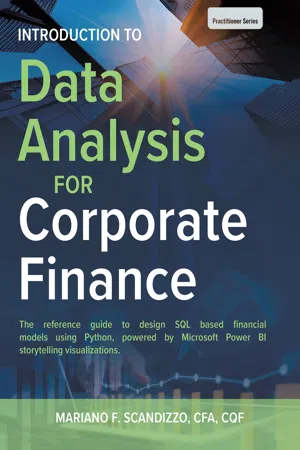
Data Analysis for Corporate Finance
Building financial models using SQL, Python, and MS PowerBI
- 520 pages
- English
- ePUB (mobile friendly)
- Available on iOS & Android
Data Analysis for Corporate Finance
Building financial models using SQL, Python, and MS PowerBI
About this book
Have you ever tried to learn to code or to use advanced visualization tools? If so, I am sure you know how daunting it is to learn by yourself.
Generally, tools and books follow an encyclopedism approach, i.e., books attempt to teach every feature about a coding language or tool. This implies hundreds, if not thousands of pages simply to tackle a single topic, whether SQL, Python, MS Excel, MS PowerBI, you name it. The journey from zero to hero to become proficient using numerical and visualization tools to take your career to the next level becomes an ordeal that requires years and thousands of pages just to begin putting the pieces of the puzzle together. However, the reality is that you do not need to learn absolutely every available feature to use those tools and deliver a superior project.
Rather than teaching you about the forest, I will discuss specific trees. Why? Because once you become familiar and confident nurturing a few trees, growing a forest becomes a simple process of planting new trees. This book provides the fundamental blocks so that you can learn about financial data science and take these tools and start using them tomorrow. The scope of the selected tools will empower you to see a considerable improvement in your financial modeling skills.
The book is designed to provide corporate finance professionals the ability to start immediately using advance tools for concrete real-world tasks.
Therefore, this book is all about functionalism. It is about providing you with tools that will put you to work and dramatically change the way you analyze data. Once you see the benefits, it will become natural to keep expanding your domain knowledge, leveraging today's endless available educational resources.
Frequently asked questions
- Essential is ideal for learners and professionals who enjoy exploring a wide range of subjects. Access the Essential Library with 800,000+ trusted titles and best-sellers across business, personal growth, and the humanities. Includes unlimited reading time and Standard Read Aloud voice.
- Complete: Perfect for advanced learners and researchers needing full, unrestricted access. Unlock 1.4M+ books across hundreds of subjects, including academic and specialized titles. The Complete Plan also includes advanced features like Premium Read Aloud and Research Assistant.
Please note we cannot support devices running on iOS 13 and Android 7 or earlier. Learn more about using the app.
Information
- Importing and exporting data into/ from a dataframe
- Manipulating data
- Table manipulations such as merge, join or concatenate
Table of contents
- Becoming a Financial Data Scientist
- Relational Databases
- Financial Data Science
- Numpy
- Pandas
- Corporate Finance Tools
- Data Visualization
- Matplotlib
- Python Primer